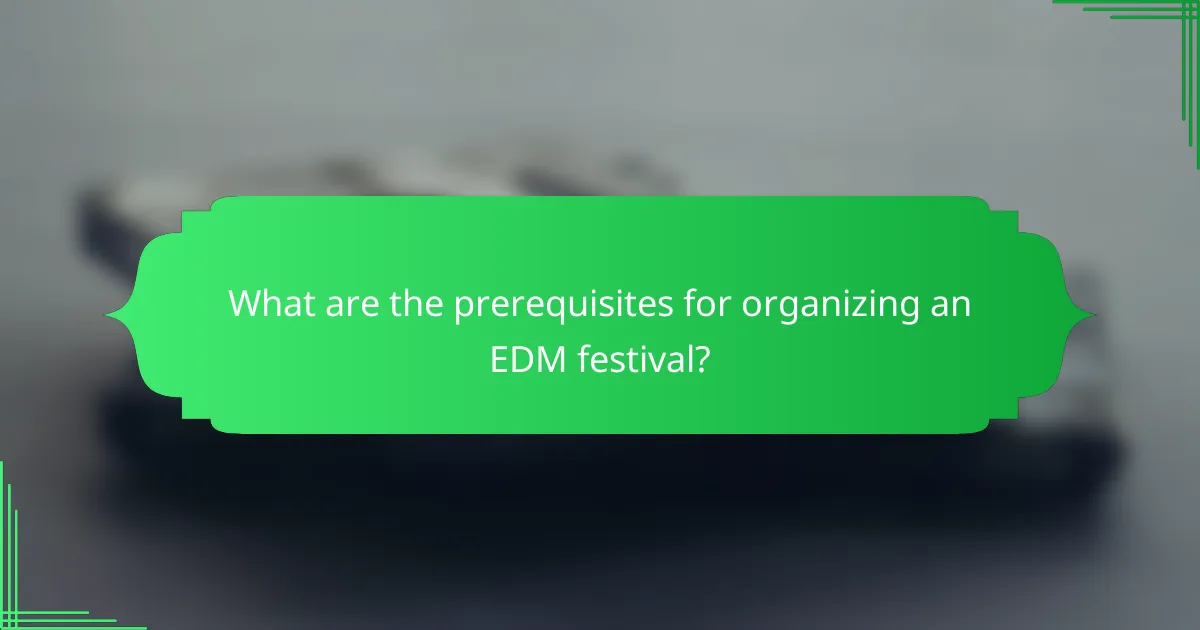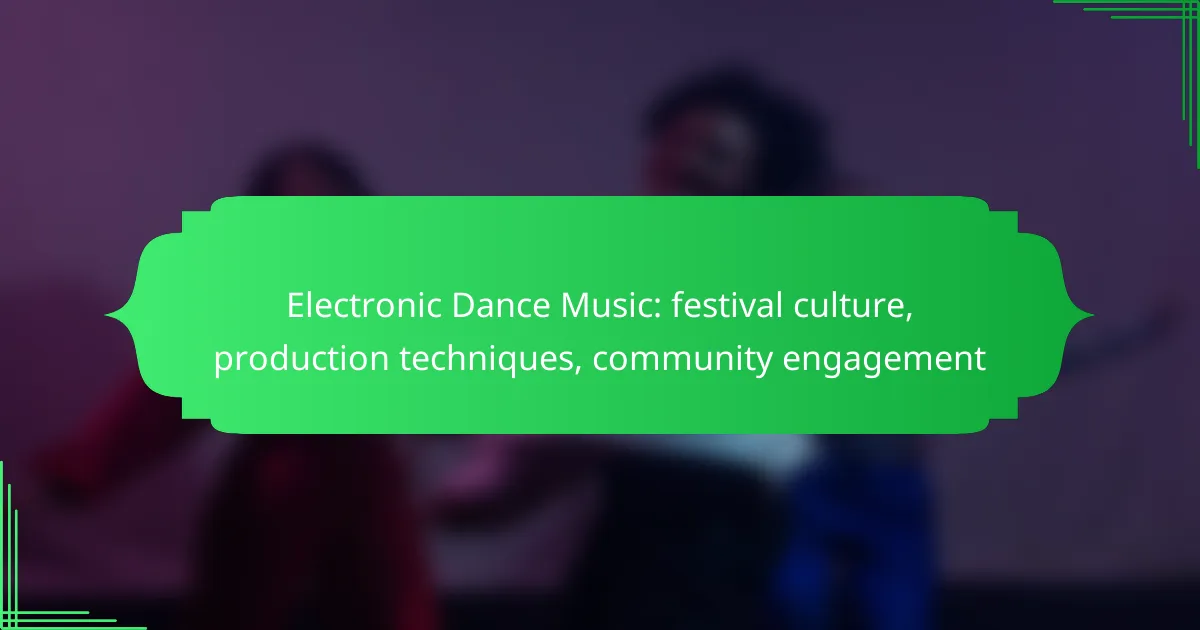Electronic Dance Music (EDM) thrives on a dynamic festival culture that fosters community engagement and drives local economies. These vibrant events not only connect artists and fans but also influence musical trends and inspire creativity. Key production techniques, such as digital audio workstations and sound design, play a crucial role in crafting the energetic sounds that define the genre. Through collaboration and inclusive spaces, artists can further enhance their connection with the community, promoting a rich cultural exchange.

How does festival culture shape electronic dance music in Canada?
Festival culture plays a significant role in shaping electronic dance music (EDM) in Canada by fostering community, influencing musical trends, and driving local economies. These events create a vibrant atmosphere where artists and fans connect, leading to a unique exchange of ideas and sounds.
Community gathering experiences
Canadian EDM festivals serve as vital community gathering experiences, bringing together diverse groups of people who share a passion for music. Events like Electric Daisy Carnival and Veld Music Festival create spaces for social interaction, where attendees can bond over shared interests and experiences.
These festivals often feature immersive environments, art installations, and interactive activities that enhance the sense of community. Attendees frequently report feelings of belonging and unity, which are essential for the growth of the EDM scene in Canada.
Influence on music trends
Festival culture significantly influences music trends within the EDM genre in Canada. Artists often debut new tracks and collaborate live, which can lead to the rapid spread of innovative sounds and styles. Festivals act as a testing ground for emerging artists, allowing them to gauge audience reactions and refine their music.
Moreover, the exposure gained from performing at festivals can catapult lesser-known artists into the spotlight, shaping the future direction of the genre. This dynamic environment encourages experimentation and keeps the music fresh and engaging for fans.
Economic impact on local areas
The economic impact of EDM festivals on local areas in Canada is substantial. These events attract thousands of attendees, leading to increased revenue for local businesses such as hotels, restaurants, and transportation services. Festivals can generate millions of dollars in economic activity, benefiting the surrounding communities.
Additionally, local governments often support these events due to their potential to boost tourism and create jobs. However, it’s crucial for organizers to consider sustainability and community engagement to ensure long-term positive effects on the local economy.

What are the key production techniques in electronic dance music?
The key production techniques in electronic dance music (EDM) include the use of digital audio workstations, sampling and sound design, and live performance integration. These techniques are essential for creating the unique sounds and energetic experiences that define the genre.
Use of digital audio workstations
Digital audio workstations (DAWs) are software platforms that allow producers to compose, edit, and mix music. Popular DAWs like Ableton Live, FL Studio, and Logic Pro provide a range of tools for arranging tracks, applying effects, and automating processes. Choosing the right DAW often depends on personal workflow preferences and specific project needs.
When working with a DAW, it’s crucial to familiarize yourself with its features, such as MIDI sequencing and audio editing. Many producers start with templates to streamline their workflow, which can save time and enhance creativity during the production process.
Sampling and sound design
Sampling involves using snippets of existing audio to create new sounds or textures in a track. This technique is widely used in EDM to incorporate diverse elements, from vocal chops to drum hits. Producers often manipulate samples through techniques like pitch shifting and time stretching to fit their compositions.
Sound design, on the other hand, focuses on creating original sounds using synthesizers and effects. Understanding synthesis methods, such as subtractive or additive synthesis, can greatly enhance your sound palette. Experimenting with different waveforms and modulation techniques can lead to unique sonic results that stand out in a crowded genre.
Live performance integration
Integrating live performance elements into EDM can elevate the audience experience. Many artists use MIDI controllers, drum machines, and synthesizers during live shows to interact with their music in real-time. This approach allows for improvisation and dynamic changes that keep performances fresh and engaging.
To successfully integrate live performance, consider rehearsing with your setup to ensure smooth transitions between tracks and effects. It’s also beneficial to create a performance-specific arrangement of your songs, focusing on energy levels and audience engagement throughout the set.

How can artists engage with their communities through EDM?
Artists can engage with their communities through EDM by creating inclusive spaces and opportunities for interaction. This can involve hosting events, collaborating with local businesses, and leveraging social media to connect with fans and promote local culture.
Hosting local events
Hosting local events is a direct way for artists to connect with their communities. These can range from small gatherings in local venues to larger festivals that celebrate local talent. Artists should consider factors like venue capacity, ticket pricing, and local regulations when planning these events.
For example, organizing a free outdoor concert can attract a diverse audience and foster a sense of community. Collaborating with local food vendors or artists can enhance the experience and support the local economy.
Collaborating with local businesses
Collaborating with local businesses can strengthen community ties and provide mutual benefits. Artists can partner with local bars, cafes, or shops to host events or showcase their music. This not only promotes the artist but also drives traffic to the business.
For instance, a local coffee shop might host a weekly open mic night featuring local DJs or producers. Such collaborations can create a vibrant local scene and encourage community members to support both the artists and the businesses involved.
Utilizing social media platforms
Utilizing social media platforms is essential for artists to engage with their communities effectively. Platforms like Instagram, Facebook, and TikTok allow artists to share their music, promote events, and interact with fans in real-time. Regular updates and interactive content can keep the audience engaged and informed.
Artists should consider creating content that highlights local culture, such as behind-the-scenes videos of events or collaborations with local influencers. Engaging with followers through polls or Q&A sessions can also foster a sense of community and encourage participation in local events.

What are the prerequisites for organizing an EDM festival?
To successfully organize an EDM festival, you need to consider several key factors including permits, venue selection, and budgeting. Each of these elements plays a crucial role in ensuring the festival runs smoothly and meets legal requirements.
Permits and regulations
Obtaining the necessary permits and adhering to local regulations is essential for any EDM festival. This typically includes event permits, noise ordinances, and health and safety regulations. Research the specific requirements in your area, as they can vary significantly between cities and countries.
Engage with local authorities early in the planning process to understand the timeline and documentation needed. Common pitfalls include underestimating the time required for approval and failing to comply with safety standards, which can lead to fines or event cancellations.
Venue selection criteria
Choosing the right venue is critical for an EDM festival. Consider factors such as capacity, location, accessibility, and facilities. A venue should accommodate the expected crowd while providing adequate space for stages, vendors, and emergency services.
Evaluate the venue’s infrastructure, including sound and lighting capabilities, as these are vital for an immersive experience. Additionally, assess the surrounding area for accommodation options and transportation links to ensure attendees can easily access the festival.
Budgeting and sponsorship
Effective budgeting is fundamental to the success of an EDM festival. Start by estimating costs for venue rental, artist fees, equipment, and staffing. It’s wise to allocate a contingency fund for unexpected expenses, typically around 10-20% of your total budget.
Sponsorship can significantly offset costs. Approach brands that align with the EDM culture and audience, offering them visibility in exchange for financial support. Create attractive sponsorship packages that outline the benefits for potential sponsors, such as branding opportunities and access to a large audience.

How do festivals in Canada compare to those in Europe?
Festivals in Canada and Europe differ significantly in terms of scale, lineup diversity, and cultural engagement. While European festivals often attract larger crowds and feature a wider variety of artists, Canadian festivals tend to focus on a more intimate experience with local talent and community involvement.
Festival size and scale
European festivals frequently host hundreds of thousands of attendees, with iconic events like Tomorrowland and Glastonbury leading the way. In contrast, Canadian festivals, such as Electric Forest and Shambhala, generally cater to smaller crowds, often ranging from a few thousand to tens of thousands, creating a more personal atmosphere.
This difference in scale can affect the overall experience. Larger festivals may offer more elaborate stages and production, while smaller festivals might prioritize community engagement and unique, immersive experiences.
Lineup diversity
European festivals typically showcase a broader range of electronic music genres and international artists, reflecting the continent’s rich musical heritage. Events like Amsterdam Dance Event and Sonar feature lineups that include both mainstream and underground acts, appealing to diverse audiences.
In Canada, festivals often emphasize local talent alongside a few international headliners. This focus on homegrown artists fosters a sense of community and allows attendees to discover emerging talent, though it may result in less genre diversity compared to European counterparts.
